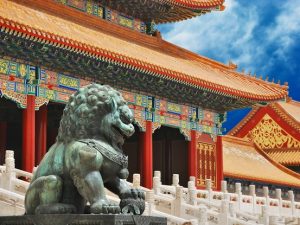Officially termed the Palace Museum (Gugong), the Forbidden City served for 500 years (until the end of the imperial era in 1911) as the source of all power in China, the throne of the Son of Heaven and the private residence of all the Ming and Qing dynasty emperors. Covering 74 hectares and containing some 800 individual buildings, the scale of the Forbidden City is hard to grasp, but visiting this monumental complex is an extraordinary experience.
Although rebuilt and restored many times through the centuries, the structures of the Forbidden City retain the design and, above all, the impressive character of the originals. Begun in 1406 and completed in 1420, construction required the labours of 200,000 workmen. The earliest of the completely original structures date to the 18th century, the older structures having been destroyed by the frequent fires to which the wooden buildings were dangerously vulnerable, and the ravages of heavy-handed conquerors with a taste for pillage. Chang an Ave. Entry is from Tiananmen Square, via the Tiananmen Gate and the Duanmen Gate to the entrance proper, which is at the Meridian Gate (Wumen).
The simplest way to tour the Forbidden City is to follow the central axis from south to north, over the Golden Stream, through the Gate of Supreme Harmony, and across the Sea of Flagstones, to the main ceremonial areas in the Hall of Supreme Harmony, the Hall of Complete Harmony, and the Hall of Preserving Harmony. Cross the Dragon Pavement to the imperial family’s private domain, through the Gate of Heavenly Purity, to the Palace of Heavenly Purity, the Hall of Union, and the Palace of Earthly Tranquillity. Cross the Imperial Gardens to the Hall of Imperial Peace and the Gate of Obedience and Purity, exiting through the Gate of Divine Prowess. Along this principal route, visits can be made to the numerous side palaces and pavilions, many of which have been laid out as galleries and museums.

Meridian Gate (Wumen)
This powerful defensive tower was built to guard the entrance to the Forbidden City. Today, it is where you buy your ticket to enter the main complex.
Gate of Supreme Harmony (Taihemen)
This gate divides the ornamental outer courtyard, with its Golden Stream, from the more formal inner courtyard of the Forbidden City’s ceremonial section. The courtyard beyond the gate could accommodate up to 100,000 people for imperial audiences.
Hall of Supreme Harmony (Taihedian)
The most substantial of the official pavilions (28m high), this was also known as the Gold Throne Hall, and was used for important state occasions, for meetings with senior ministers, and for celebrating the emperor’s birthday. Incense burners stand before the entrance, one in the shape of a stork, and another in the shape of a dragon; both were auspicious symbols to an emperor. Numerous less ornate burners surround the building. Yellow tiles line the roof of the double-eaved structure, and rows of mythical animals, exquisitely rendered in miniature, face the corners. The tiled floor and gold-painted columns entwined with carved dragons are surmounted by a green-and gold-painted ceiling, littered with dragon motifs, from which hangs a spherical mirror. Beyond the Hall ot Supreme Harmony’s tourist-mobbed splendour, you must try to picture the majestic court rituals that took place here: the kowtowing courtiers in splendid robes, clouds of incense smoke, and above all the august figure of the emperor himself, presiding from the fantastically ornate Dragon Throne.

Hall of Complete Harmony (Zhonghedian)
Somewhat less formal than the Hall of Supreme Harmony and the Hall of Preserving Harmony, this elegant little square hall was used by the emperor as a resting point, and as a place for practising ceremonial speeches and actions. The dragons painted on the ceiling would have reminded officials that ‘relaxation’ was a relative term in the emperor’s presence. Qing dynasty sedans, used for transporting the emperor around the palace, are on display.
Hall of Preserving Harmony (Baohedian)
Highly decorated, and with ornate ceilings and beams, this graceful hall was used for imperial banquets, as a changing room for the emperor before official ceremonies, and as an examination centre for candidates for senior positions within the imperial bureaucracy. Behind the hall, a giant slab of marble, weighing more than 200 tonnes, is inscribed with dragon and cloud motifs.

